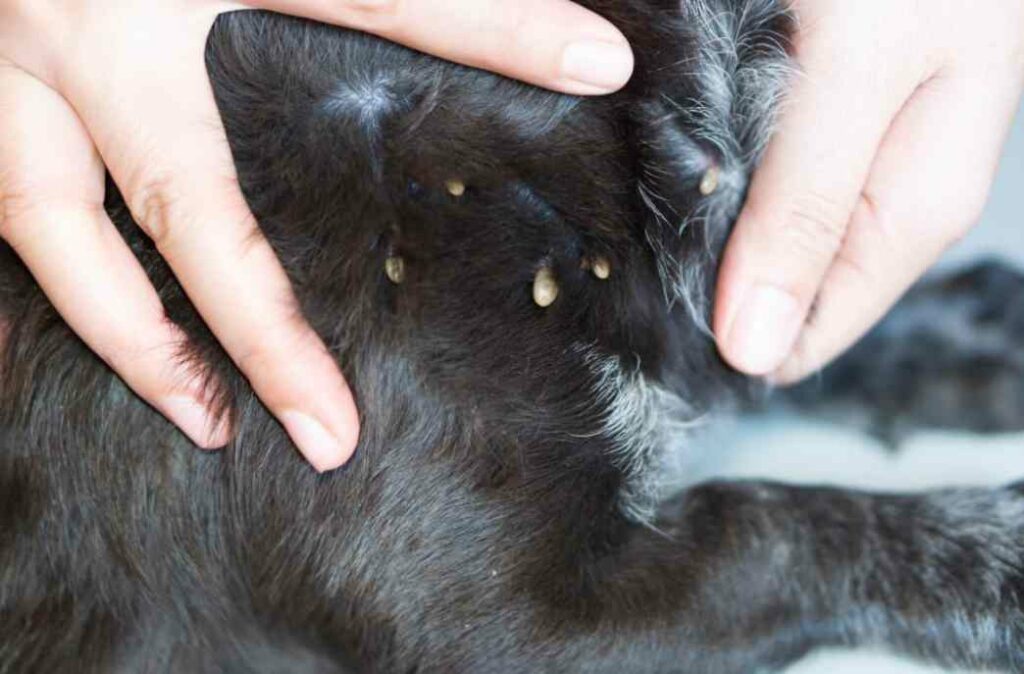Protecting Your Dog from Tick-Borne Diseases
Ticks are little arachnids that feast on our pets’ blood. Over 900 species of these parasitic insects exist worldwide, with 100 found in the US. Unfortunately, ticks can transmit dangerous pathogens when they bite.
Several tick-borne illnesses are rising in dogs, including Lyme disease, Anaplasmosis, ehrlichiosis, and Rocky Mountain spotted fever. Lyme alone affects over 250,000 pets annually. Left untreated, these diseases can cause fever, lameness, neurological issues, and even death in severe cases.

Table of Contents
- Canine tick-borne diseases
- Treatment of tick-borne diseases in dogs
- Treating bacterial vs. protozoal tick-borne diseases in dogs
- Prevent tick-borne diseases in dogs
- Prognosis for dogs with tick-borne diseases
- How Long Do Tick Bite Symptoms Take to Appear in Dogs?
- What diseases do dog ticks transmit to humans?
- Conclusion
Canine tick-borne diseases
Canine tick-borne diseases are illnesses caused by pathogenic microorganisms, primarily bacteria and some viruses, transmitted to dogs through tick bites.
The most common tick-borne diseases in dogs are:
- Ehrlichiosis – caused by Ehrlichia bacteria, can lead to fever, lameness, and bleeding disorders.
- Lyme Disease – caused by Borrelia burgdorferi bacteria, can cause lameness, kidney disease, and neurological issues.
- Rocky Mountain Spotted Fever – caused by Rickettsia rickettsii bacteria, can result in fever, neurological problems, and blood clotting issues.
- Anaplasmosis – caused by Anaplasma bacteria, leads to fever, anemia, and platelet deficiencies.
- Hepatozoonosis – caused by Hepatozoon parasites, leads to muscle pain and ocular issues.
- Bartonellosis – caused by Bartonella bacteria, leads to endocarditis and neurological disorders.
- Babesiosis – caused by Babesia parasites, causes hemolytic anemia and potentially kidney failure.
Tick-borne diseases often have overlapping symptoms like fever, lethargy, and joint pain. Prompt antibiotic treatment and supportive care are essential for treating canine tick diseases. Prevention through tick control products is key to reducing risk.
Lyme disease in dogs
- Caused by Borrelia burgdorferi bacteria transmitted by deer ticks after 36-48 hours of attachment
- Symptoms can include fever, lameness, lethargy, kidney disorders, and arthritis
- Diagnosed via C6 antibody blood test, which detects a response to B. burgdorferi protein
- Treatment involves a 4-week course of antibiotics like doxycycline, though Lyme is difficult to cure fully
- Preventative vaccines are available to reduce risk in tick-prone areas
- High risk for outdoor breeds like Dutch Shepherds, who can get frequent tick exposure
- Humans cannot catch Lyme disease directly from an infected dog
- But infected ticks can spread B. burgdorferi to both dogs and people, so tick control is imperative
If not treated promptly, Lyme disease can lead to chronic health issues for dogs. Where appropriate, prevention through tick control, testing, and vaccination can help reduce risk. Being vigilant about tick checks on pets and ourselves is critical to prevention.
Canine granulocytic ehrlichiosis
- Caused by Ehrlichia bacteria, primarily E. canis, transmitted by ticks like the brown dog tick
- Symptoms appear 1-3 weeks after tick bite but can be delayed months or years in some dogs
- Early signs include fever, breathing issues, swollen lymph nodes, weight loss
- The disease progresses through acute, subclinical (no symptoms), and chronic phases
- Diagnosis via blood tests and PCR test to detect Ehrlichia DNA
- Bacteria must be present for 2-3 weeks for a positive test result
- Treatment involves doxycycline or tetracycline antibiotics
- No vaccine is available, so tick prevention through products like collars is crucial
- Humans cannot directly get ehrlichiosis from dogs
- But infected ticks can spread it to both humans and canines
Though ehrlichiosis can be asymptomatic in dogs for long periods, progression to the chronic phase can be debilitating. Early diagnosis and treatment are essential, but diligent tick control is the best way to protect dogs from this bacterial disease. Checking dogs thoroughly for ticks and using preventives is recommended, even if pets appear healthy.
Canine Anaplasmosis
- Caused by Anaplasma phagocytophilum bacteria transmitted by deer ticks and black-legged ticks
- Often co-infects dogs along with Lyme disease due to the same tick vector
- Symptoms appear 1-7 days after bite – fever, lethargy, lameness, appetite loss
- Less common symptoms are vomiting, diarrhea, seizures, breathing issues
- Diagnosis requires a specific veterinary testing kit to detect Anaplasma
- Treatment involves a 2-3 week course of doxycycline antibiotic
- Dogs may still test positive after treatment completion
- It’s unclear if infection becomes “reactivated” later on
- No vaccine available – prevention with tick control is vital
- Not known to be transmissible from dogs to humans
Prompt diagnosis and antibiotic treatment is essential for canine Anaplasmosis. However, diligent tick control through collars, spot-ons, etc., is the best way to protect dogs from this emerging disease. Anaplasmosis is an essential reminder to check pets thoroughly for ticks and not rely on testing when symptoms appear.
Rocky Mountain spotted fever in dogs

- Caused by Rickettsia rickettsii bacteria spread by ticks like the American dog tick
- Can be contracted throughout the US, not just the Rocky Mountain region
- A tick must be attached for 5+ hours to transmit bacteria
- Symptoms include fever, joint pain, reduced appetite, neurological issues
- The disease also causes low platelet count, bleeding disorders, skin lesions
- High mortality rate if not diagnosed and treated promptly
- Diagnosis via blood tests, treatment involves aggressive antibiotics
- The infection lasts around 2 weeks with timely treatment
- It is not transmitted from dogs to humans, but humans can get infected from tick bites
Rocky Mountain spotted fever progresses rapidly in dogs and can be fatal if not treated quickly. Prevention through diligent tick checks and control is key, as is rapid veterinary care if symptoms develop. While not contagious from dogs, RMSF is an essential reminder for pet owners to protect themselves from tick bites.
Canine bartonellosis
- It is caused by various Bartonella bacteria species, not actual cat scratches
- Transmitted to dogs by ticks and fleas
- Symptoms include intermittent fever, lameness, lethargy
- There is no known cure yet, and bacteria show antibiotic resistance
- Treatment involves long-term multiple antibiotics
- It can lead to endocarditis, myocardial disease, neurological issues
- Highly prevalent in stray dog populations
- Humans cannot get bartonellosis directly from dogs
- But humans can contract Cat Scratch Fever from fleas and ticks
Bartonellosis is challenging to treat in dogs due to antibiotic resistance. Prevention through vigilant flea/tick control is essential. While not transmissible from dogs, bartonellosis reminds us that humans are also at risk from these pathogens via vector insect bites. Continued research on treatment is needed to better manage this persistent infection in dogs.
Tularemia in dogs
- Also known as “rabbit fever,” it is caused by Francisella tularensis bacteria
- Transmitted by ticks and fleas, more common in cats than dogs
- Symptoms are mild – low fever, lethargy, depression, loss of appetite
- No vaccine is available yet. Prevention through tick/flea control is key
- Treatable with an antibiotic prescription from a veterinarian
- Humans cannot contract tularemia directly from infected dogs
- But humans can get infected through tick and flea bites
Tularemia tends to be milder in dogs compared to other species. However, prevention is still vital as no vaccine exists yet. While not transmissible from dogs, tularemia illustrates the need for tick and flea control measures to protect pets and humans from vector-borne diseases. Antibiotic treatment is effective when tularemia is diagnosed.
Haemobartonellosis in dogs
- Caused by Mycoplasma haemocanis bacteria transmitted by ticks and fleas
- Targets and damages red blood cells, leading to anemia
- Often, there are no visible symptoms unless the dog has a pre-existing condition
- Diagnosis requires blood analysis – should test annually
- Treatment involves antibiotics like doxycycline for a few weeks
- May need supportive care like blood transfusions
- Dogs with compromised immune systems are most at risk
- Prevention is vital through year-round tick/flea control
Haemobartonellosis can silently infect dogs without clear symptoms. Annual screening ensures detection and allows for prompt treatment. Prevention is critical, especially for vulnerable dogs, as haemobartonellosis can lead to severe, even fatal anemia if left untreated. Like many tick-borne diseases, it is an essential reminder for pet owners to be vigilant about parasite control and testing.
Protozoal tick-borne diseases in dogs
- Babesiosis – Caused by Babesia parasites, often spread by deer ticks. Leads to hemolytic anemia and liver/kidney issues.
- Hepatozoonosis – Caused by Hepatozoon parasites, spread by brown dog ticks. It causes muscle pain and ocular issues.
- Cytauxzoonosis – Caused by Cytauxzoon felis parasite, spread by Lone Star ticks. Fever, breathing trouble, anemia. Often fatal.
- Theileriosis – Caused by Theileria parasites, spread by ticks. High fever and enlarged lymph nodes are common symptoms.
- Leishmaniasis – Caused by Leishmania parasites, spread by sand flies. Skin lesions and kidney failure can occur.
These protozoal diseases can be severe if not treated promptly. Prevention through year-round tick/parasite control is crucial, as is avoiding contact with infected dogs. Annual screening helps detect infection early when treatment is most effective. Vaccines are available for some protozoa like Leishmania to reduce risk.
Canine Babesiosis
- Caused by Babesia parasites, spread by ticks like the deer tick
- It can also be transmitted by bite from an infected dog with oral lesions
- Parasite destroys red blood cells, leading to anemia
- Symptoms include pale gums, jaundice, dark urine, lethargy
- Diagnosis requires specific blood smear tests
- Treatment involves multiple medications like imidocarb
- No vaccine is available currently; tick prevention is crucial
- Preventive measures include tick collars, spot-on repellents
Babesiosis can be severe and requires prompt diagnosis and treatment. Preventing tick exposure is extremely important, as is avoiding contact with infected dogs. Annual screening is recommended for early detection, especially in endemic areas. More research is needed to develop an effective vaccine against the Babesia parasite.
American canine hepatozoonosis (ACH):
- Caused by Hepatozoon americanum parasite
- Spread by ingestion of infected Gulf Coast ticks
- Also acquired by eating prey with infected tick larvae
- Symptoms include fever, anorexia, pain, muscle loss, ocular discharge
- Diagnosis via blood tests, possibly muscle biopsy
- Treatment involves long-term antibiotics, which can be challenging
- If untreated, ACH is draining and can be fatal
- Not transmissible from dogs to humans
ACH is acquired uniquely through tick ingestion rather than bites. Prompt diagnosis and extended antibiotic treatment are crucial but challenging. Prevention revolves around avoiding the ingestion of wildlife and controlling ticks on-premises. While not contagious to humans, ACH is a reminder that multiple vectors can transmit tick-borne pathogens in less expected ways.
Tick paralysis in dogs
- Caused by a neurotoxin secreted in tick saliva during bites
- Symptoms start 24hrs-1 week after the bite with hindlimb weakness
- Progresses to affect all 4 limbs, breathing, and swallowing as the toxin spreads
- Caused by multiple tick species like the Rocky Mountain wood tick
- Diagnosis based on symptoms and finding an attached tick
- Treatment involves tick removal and tick antiserum injections
- Early detection and treatment allow full recovery
- Without treatment, paralysis and respiratory failure can occur
- Prevention involves diligent tick checks and prompt removal
Tick paralysis is frightening but treatable if caught early. Daily tick checks and prompt removal are crucial for prevention. If any weakness develops, immediate veterinary care is essential to halt progression. Public awareness is important to recognize tick paralysis quickly and save dogs from fatal respiratory paralysis.
puppiesdiary.com
Treatment of tick-borne diseases in dogs

- Antibiotics are the primary treatment for most tick-borne bacterial and protozoal diseases
- Doxycycline is a commonly prescribed antibiotic, as well as tetracycline
- Other medications used: imidocarb for Babesiosis, amphotericin B for Leishmaniasis
- Treatments are most effective when started early after infection
- Diagnosis is essential to identify specific pathogens for proper antibiotic
- Blood tests and PCR tests are used to diagnose and verify treatment efficacy
- Treatment length ranges from 2 weeks for Anaplasmosis to years for ACH
- Supportive care like fluids and blood transfusions are helpful in severe cases
- Ticks must be removed properly to halt additional toxin secretion
- Tick antiserum can be used to treat tick paralysis
- Prevention through tick control is imperative to reduce disease risk
The array of pathogens transmitted by ticks makes accurate diagnosis critical. Prompt and proper antibiotic treatment and diligent tick control by pet owners offer the best protection against potentially devastating tick-borne diseases in canine companions.
Treating bacterial vs. protozoal tick-borne diseases in dogs
Bacterial Diseases:
- Respond well to antibiotics like doxycycline, tetracycline, etc.
- Improvement is typically seen within 2-4 weeks of starting antibiotics
- Testing is essential to identify bacteria for proper antibiotic selection
- A complete treatment course often takes 4-6 weeks, depending on the disease
Protozoal Diseases:
- It is more challenging to treat and often requires multiple medications
- Medications include imidocarb (Babesiosis), miltefosine (Leishmaniasis)
- Treatment can take months or years, depending on the disease
- Supportive care like transfusions often required
- Prevention through tick/flea control is essential
- Vaccines available for some protozoa like Leishmania
While antibiotics can effectively treat many bacterial tick diseases, protozoal infections are more persistent. Extended treatment, diligent prevention, and owner vigilance are crucial in managing protozoal diseases. However, prompt diagnosis and early treatment give dogs the best chance of recovery.
puppiesdiary.com
Prevent tick-borne diseases in dogs
- Annual veterinary screening tests and vaccines where available
- Use monthly/weekly tick preventives like Nexgard Seresto collars
- Check dogs thoroughly for ticks daily, especially after time outdoors
- Carefully remove any found ticks with tweezers near the skin
- Ask a veterinarian about tick disease prevalence in your area
- Avoid areas with heavy tick infestation when possible
- Keep grass mowed and clear leaf litter where ticks congregate
- Treat dogs and home with acaricides to kill ticks
- Limit contact with stray/wild animals that may carry ticks
- Be vigilant year-round, even in cooler weather
- Seek prompt vet care if any symptoms develop post-tick bite
A multi-layered approach is best – combining veterinary prevention, tick control products, environmental management, and thorough tick checks. Staying informed on local tick patterns, performing frequent inspections, and getting immediate care for any concerns can help protect dogs from developing devastating tick-borne diseases.
Prognosis for dogs with tick-borne diseases

- The prognosis depends on the specific condition and how early it is diagnosed
- Some tick-borne diseases can be fatal if untreated (RMSF, Cytauxzoonosis)
- Even with treatment, recovery can take weeks or months for many diseases
- Hospitalization may be needed for more severe infections
- Recurrence is possible even after treatment
- Continued antibiotic therapy is essential even as the dog starts to improve
- Adequate rest and supportive care aid recovery
- Lifelong treatment may be required for chronic diseases like ACH
- Prevention of reinfection through tick control is critical
- Routine screening helps detect infection before symptoms emerge
The prognosis is generally good if tick diseases are caught early. But, these infections can still carry morbidity even with treatment. Continued prevention and monitoring are key to reducing flare-ups. Proactive tick control and vigilant owner awareness provide the best protection.
How Long Do Tick Bite Symptoms Take to Appear in Dogs?
The incubation time for these tick-borne illnesses can range dramatically from just 3-6 hours to several months post-bite!
Diseases like Rocky Mountain spotted fever can show symptoms in dogs in less than 24 hours due to the quick replication of Rickettsia rickettsii bacteria.
However, Lyme disease caused by Borrelia burgdorferi can take 2-5 months for initial fever and lameness to emerge. This broad timeframe makes diagnosis a challenge.
Anaplasmosis, ehrlichiosis, and other common tick diseases typically cause symptoms 1-2 weeks after initial bite and transmission.
However, some dogs may not show signs for months due to dormant infection phases. Ticks must usually be attached over 24-48 hours to transmit pathogens.
What diseases do dog ticks transmit to humans?
Dogs can bring infected ticks into the home, biting and infecting humans. The main tick-borne diseases that dogs can expose people to through this route include:
- Lyme Disease – Caused by Borrelia burgdorferi bacteria, transmitted by deer ticks/black-legged ticks. Dogs are susceptible, and help introduce ticks to humans.
- Anaplasmosis – Caused by Anaplasma phagocytophilum, transmitted by deer ticks and western black-legged ticks. Dogs and humans are both at risk.
- Ehrlichiosis – Caused by Ehrlichia bacteria like E. chaffeensis, transmitted by Lone Star ticks. Infects both canine and human hosts.
- Rocky Mountain Spotted Fever – Caused by Rickettsia rickettsii, spread by American dog ticks and brown dog ticks. A tick can spread to dogs, humans, and other mammals.
- Tularemia – Caused by F. tularensis, spread by dog and deer ticks. Dogs can bring infected ticks into contact with humans.
The key is diligent tick prevention and checking dogs closely for ticks after time outdoors before they come indoors and have a chance to bite human family members. Prompt tick removal is crucial. Vaccines, medications, and limiting tick habitat can reduce the risk of transmission from ticks that dogs attract.
Conclusion
The key is prevention and early treatment. Talk to your vet about tick prevention products like Nexgard and Bravecto chewable, which kill ticks quickly after biting. Check your dog thoroughly for ticks daily, especially after time outdoors. Remove any you find ASAP with tweezers.
If symptoms develop like lethargy, swollen joints, or loss of appetite, get your dog tested for tick diseases right away. Catching illnesses early makes treatment with antibiotics much more effective! With diligence, we can protect our four-legged friends from these hazardous hitchhikers in 2023 and beyond.


![Canine Epilepsy Symptoms, Stages, Diagnosis, And Treatment Process [Vet Advice] 6 Canine Epilepsy Symptoms, Stages, Diagnosis, And Treatment Process [Vet Advice]](https://www.puppiesdiary.com/wp-content/uploads/2023/11/Canine-Epilepsy-Stages-768x528.jpg)


![How Can I Treat A Hole In My Dog's Skin? [3 Hidden Tips To Fast Cure] 9 How Can I Treat A Hole In My Dog’s Skin? [3 Hidden Tips To Fast Cure]](https://www.puppiesdiary.com/wp-content/uploads/2023/04/How-Can-I-Treat-A-Hole-In-My-Dogs-Skin-768x456.webp)
